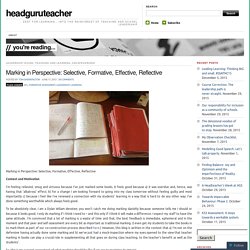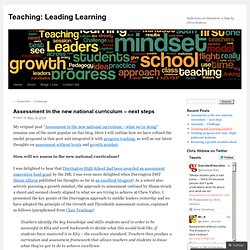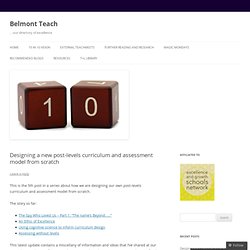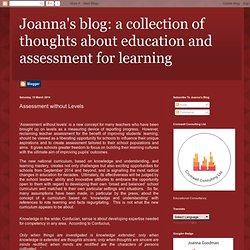

Badge Systems. Educational Technology and Mobile Learning: Awesome Poster: Bloom's Taxonomy Rose. REAP - Resources > Assessment Principles: Some possible candidates. Additional Resources: Below are three sets of principles that might be used to guide the design of assessment in higher or further education.

The first set, of which there are 11, has informed the work of the Reengineering Assessment Practices (REAP) project (www.reap.ac.uk). The second set are a more comprehensive list developed at the University of Strathclyde by the Assessment Working Group who have been tasked with reformulating the policy and practice of assessment across the institution. The final set of 7, were proposed in the US by Chickering and Gamson (1991) based on their review of good undergraduate education. These principles are a starting point in trying to understand the relationship between the theory and practice of assessment. Marking in Perspective: Selective, Formative, Effective, Reflective. Marking in Perspective: Selective, Formative, Effective, Reflective Context and Motivation I’m feeling relieved, smug and virtuous because I’ve just marked some books.

It feels good because a) it was overdue and, hence, was having that ‘albatross’ effect; b) for a change I am looking forward to going into my class tomorrow without feeling guilty and most importantly c) because I feel like I’ve renewed a connection with my students’ learning in a way that is hard to do any other way; I’ve done something worthwhile which always feels good. To be absolutely clear, I am a Dylan Wiliam devotee; you won’t catch me doing marking slavishly because someone tells me I should or because it looks good; I only do marking if I think I need to – and this only if I think it will make a difference. I expect my staff to have the same attitude. What are the advantages and disadvantages of portfolio assessment? Last month on the blog I mentioned that my school was dipping its toes into formative assessment in the form of writing portfolios.

Overall, I’m very happy with the way it’s going, noting the advantages I discussed in my previous post. Nevertheless, it hasn’t been all plain sailing! With this in mind, I thought a follow up post might be in order, one in which I attempt to balance the pros and cons! Formative assessment, just to get you all up to speed, covers the range of informal diagnostic tests and techniques, such as learner portfolios, us teachers can use to assist the process of learning by our learners. Assessment in the new national curriculum – next steps. My original post “Assessment in the new national curriculum – what we’re doing” remains one of the most popular on this blog.

Here I will outline how we have refined the model proposed in that post and integrated it with progress tracking, as well as our latest thoughts on assessment without levels and growth mindset. How will we assess in the new national curriculum? I was delighted to hear that Durrington High School had been awarded an assessment innovation fund grant by the DfE. I was even more delighted when Durrington DHT Shaun Allison published his thoughts so far in an excellent blogpost!
As a school also actively pursuing a growth mindset, the approach to assessment outlined by Shaun struck a chord and seemed closely aligned to what we are trying to achieve at Chew Valley. In the Chew Valley version, we will continue to use GCSE grades as the basis for our assessment model. We have not yet decided when we will shift over to 1-9 grades.
Progress flight paths tabulated. PE Assessment without levels. This guest post was written by Tom Williams @MrWilliams_PE.

I have been spending the last couple of months working with a team of teachers at school as part of an “assessment panel” to try and create a way of assessing in KS3 without levels but still with relevant rigour. The example below is the culmination of a whole school template, and part of an @PE4Learning template. There are 10 main assessment strands in the table. They are: • Leadership • Coaching • Performance • Decision Making • Mind Set • Character • Fitness • Extra Curricular • Knowledge • Organisation Students will receive a score out of 10 for each of those strands based on the descriptors.
The 6 words up the side of the template: Entry Level, Emerging, Developing, Secure, Confident, and Exceeding are from an art colleague at my school and will be spread throughout our Academy. Assessment Without Levels. This page will be used to post updates on our successful DfE ‘Assessment Innovation Fund’ project.

An outline of our proposed method of assessment without levels (AWL) can be viewed here. Thursday 1st May: DfE announce successful ‘assessment innovation fund’ schools. Link here. Friday 16th May: 3 Assessment Innovators appointed to develop AWL in clusters of foundation subjects: Humanities – Ben CrockettArt & Design – Emma WadePE & Performing Arts – Jack Corbett They will work alongside other subject leaders to form our ‘Assessment Innovation Team’, who will develop the ‘Growth & Thresholds’ (G&T) model. Assessment With and Without Levels in PE. Assessment Without Levels. Assessment Without Levels Homepage. Designing a new post-levels curriculum and assessment model from scratch. This is the 5th post in a series about how we are designing our own post-levels curriculum and assessment model from scratch.

The story so far: This latest update contains a miscellany of information and ideas that I’ve shared at our second curriculum conference and most recently at the Dare to imagine – Education for the 21st century conference and the Cramlington Festival of Learning TeachMeet. It attempts to pull together more detail on: context and why we are moving away from levelsthe interplay between curriculum planning and assessmenttracking of progress It also includes a number of curriculum planning tools that could be used to adopt a common planning framework. A new taxonomy? Most of us are familiar with Bloom’s taxonomy and the SOLO taxonomy, however, the end of statutory levelled assessment has brought with it a new kind of taxonomy that can be used to describe the various behaviours people often seem to exhibit in response:
Joanna's blog: a collection of thoughts about education and assessment for learning: Assessment without Levels. The new national curriculum, based on knowledge and understanding, and learning mastery, creates not only challenges but also exciting opportunities for schools from September 2014 and beyond, and is signalling the most radical changes in education for decades.

Ultimately, its effectiveness will be judged by the school leaders’ ability and innovative attitudes to embrace the opportunity open to them with regard to developing their own ‘broad and balanced’ school curriculum well matched to their own particular settings and situations. So far, many assumptions have been made, in particular by the press, about the concept of a curriculum based on ‘knowledge and understanding’ with references to rote learning and facts regurgitating. This is not what the new curriculum appears to be about. Knowledge in the wider, Confucian, sense is about developing expertise needed for competency in any area. According to Confucius, Instant access to information has never been easier.